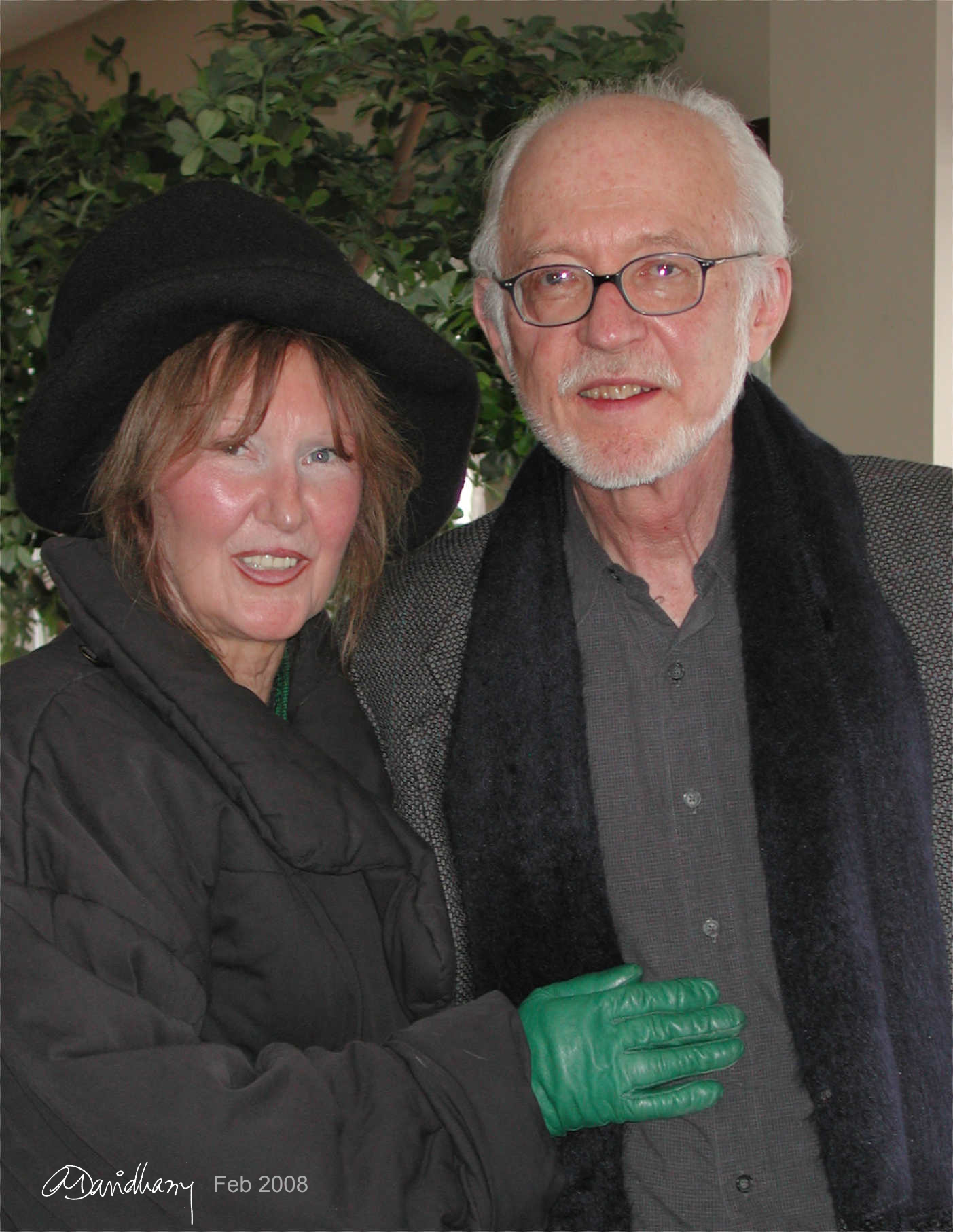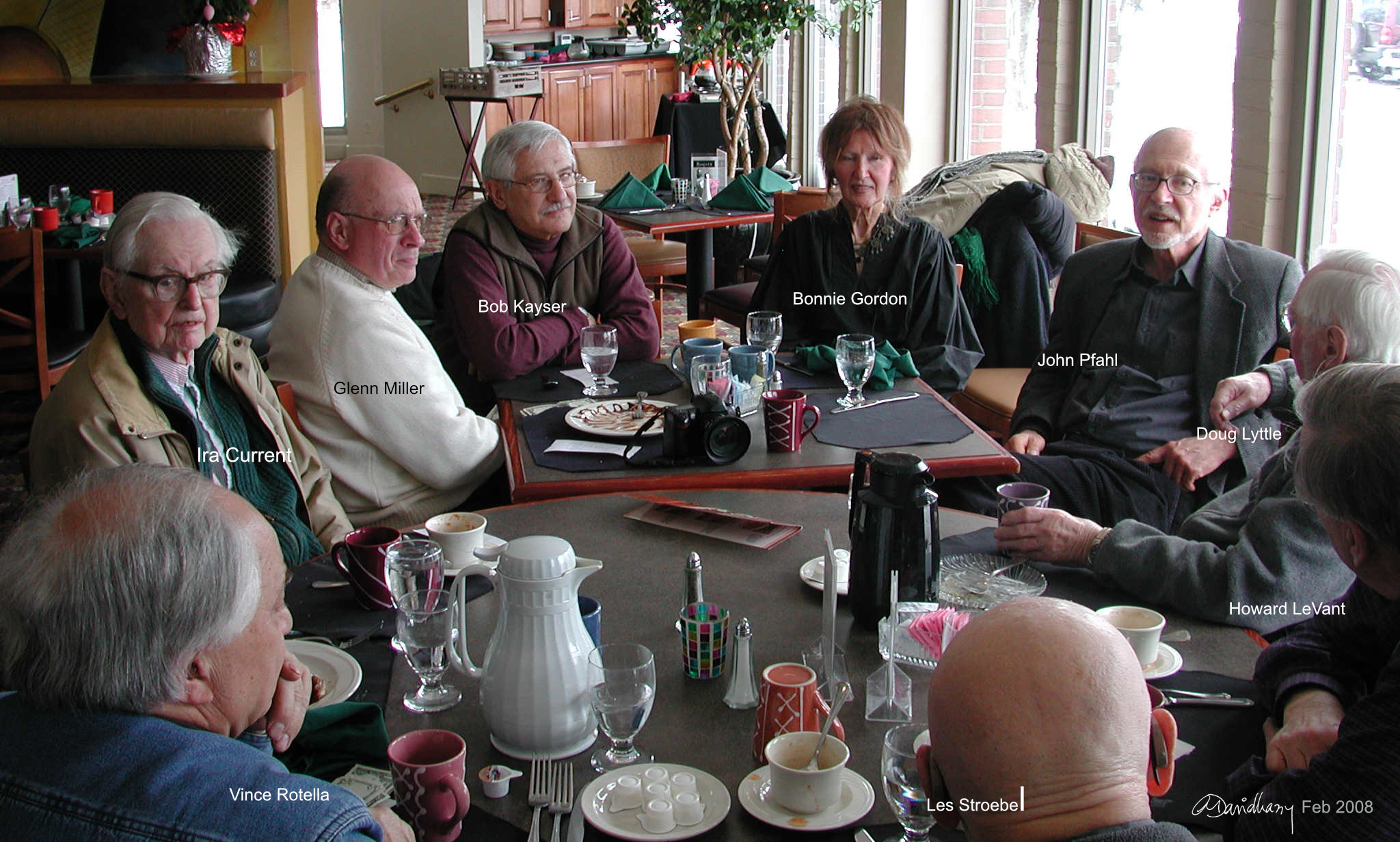|
John Pfahl, 81, world renowned photographer focused lens on Buffalo
 
click on images to see larger
Photographer John Pfahl is
seen with his wife, Bonnie Gordon in February, 2008nwhen he came
to visit the retired faculty from the School of Photographic arts and
Sciences at their periodic lunch get togethers
Feb. 17, 1939
– April 15, 2020
Reprinted from the Buffalo News
"John Pfahl could make even a heap of garbage look beautiful."
That's how Buffalo News Art Critic Richard Huntington in 2000 summed up
the humorous, inspired work of John Pfahl, whom Huntington described as
"one of the most widely esteemed of Buffalo's nationally recognized
photographers."
Making garbage look beautiful, Huntington wrote, was what Mr. Pfahl did
in his 1992 series, "From the Very Rich Hours of a Compost Pile."
Huntington wrote, "Watermelon rinds, orange peels, bean pods, cabbage
leaves and other assorted table scraps in various stages of
decomposition are discovered by Pfahl's flawless eye to be the unlikely
source of ravishing displays of color and quite rational compositions."
Mr. Pfahl died April 15 in Sisters Hospital. He had survived lymphoma
in 1990 and "had multiple life-threatening conditions which were
exacerbated to the point of death by Covid-19," his family said. He was
81.
"I want to make photographs whose very ambiguity provokes thought,
rather than cuts it off prematurely," Mr. Pfahl once said. "I want to
make pictures that work on a more mysterious level, that approach the
truth by a more circuitous route."
For his 1994-1998 "Piles" series, Mr. Pfahl photographed a topsoil pile
at a nursery, sand piles on the Buffalo Ship Canal and heaps of leaves
and car tires.
"Ansel Adams had his beloved Sierras," Mr. Pfahl said at the time. "I
seek out the more elusive mountains on the lake plain near my home in
Buffalo, New York. I try to imbue these piles of raw and recycled
materials, through judicious use of light, atmosphere and scale, with
the majesty of mountains I recall from summers in the Rockies and the
Alps."
"John Pfahl was undeniably Buffalo's most revered and accomplished
photographer, who was widely admired and respected for his creative
talent and generosity of spirit," said Gerald Mead, an artist, curator
and lecturer in the Art and Design Department at SUNY Buffalo State who
has collected Mr. Pfahl's work for 25 years. "His artistic legacy is
justifiably preserved in numerous museum and private collections in
Western New York, across the U.S. and abroad."
Born in New York City, the first of two sons of German immigrants Hans
and Anna Gerhardt Pfahl, he grew up in Wanaque, N.J.
He was given his first camera, a baby Brownie, when he was 8, but
according to his biography posted by the Janet Borden Gallery in
Brooklyn, "soon appropriated his mother's 35 mm Voigtlander."
After winning a scholarship to Syracuse University, Mr. Pfahl studied
advertising design, but some elective courses in photography altered
his career path. He earned a bachelor's degree in art in 1961, then
hitchhiked around Europe for a summer. He served two years in the Army
with an engineering battalion in Fort Belvoir, Va., before being
discharged in 1963.
He worked as assistant to photographers in New York City and Los
Angeles, then married Bonnie Gordon, a Buffalo native, in the late
1960s in Albuquerque, N.M. In the early 1970s, they moved to Buffalo
for Mrs. Pfahl's job as professor of design at Buffalo State.
Mr. Pfahl earned a master's degree from the Syracuse University School
of Communications in 1968, the same year he began teaching at the
School of Photography at Rochester Institute of Technology, where he
became a full professor.
From 1983 to 1984, he was a visiting professor at the University of New
Mexico in Albuquerque, and in 1985 he retired from RIT to concentrate
on his photography. He continued to contribute a scholarship each year
to an RIT student.
In 1992, referring to Mr. Pfahl's "Waterfalls," Huntington wrote, "John
Pfahl is so subtle it hurts. In almost painfully beautiful images, he
first tells us that nature – the 'sublime' nature of the past century –
is no more."
For "Permutations on the Picturesque," he photographed pastoral scenes
in Wales, Great Britain and Italy, then scanned his images and
manipulated them, sometimes making the sky more dramatic "or placing
sheep in the meadow to make the scene more pastoral," wrote News
reviewer Mark Lavatelli in 1999. "To remind viewers that these are
digital prints, he included narrow bands of enlarged pixels."
For his series "Extreme Horticulture," wrote Huntington, Mr. Pfahl
"subtly, and with great ingenuity, imposes his own subversive view by
pointing up small but surprising visual occurrences."
In 1990, the Albright-Knox Art Gallery organized a major retrospective
of his work, "A Distanced Land: The Photographs of John Pfahl," which
was shown in Chicago, Los Angeles and Atlanta. His most recent
exhibition, "Lake to Lake" with Amos W. Sangster, ran from April to
January in the Castellani Art Museum of Niagara University.
His work is held in many collections, including those of the Art
Institute of Chicago, the Getty Museum in Los Angeles, the Metropolitan
Museum of Art and the Museum of Modern Art in New York, the Museum of
Fine Arts in Boston and the San Francisco Museum of Modern Art.
His work was exhibited across the country and he had solo exhibitions
all over the world, including Paris, Milan, Belgium, Ottawa, Tokyo,
Germany and Spain. Locally, he exhibited at the Albright-Knox, the Nina
Freudenheim Gallery and the Burchfield Penney Art Center.
He also was involved with Artpark in Lewiston from 1974 to 1984.
In 2009, he was named educator of the year at the Dallas conference of
the Society for Photographic Education. In 1975 and 1990, he received
National Endowment for the Arts photographer's fellowships. He was
given an honorary doctorate of fine arts in 1979 by Niagara University.
Mr. Pfahl enjoyed gardening, travel, was a "passionate fan" of opera
and classical music and had "a deep interest in people," his family
said. He also had "a very silly side to his humor," said his wife,
Bonnie Gordon.
Survivors also include a brother, Walter, two nieces and two nephews.
His family said plans for services are on hold.
|